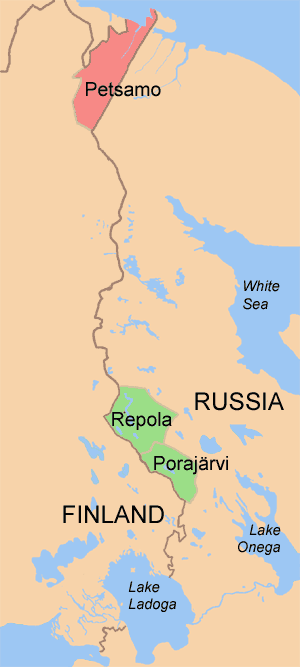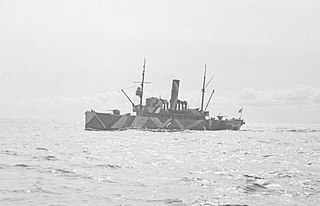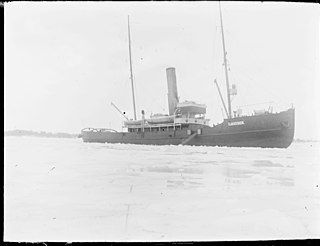
The Finnish Navy is one of the branches of the Finnish Defence Forces. The navy employs 2,300 people and about 4,300 conscripts are trained each year. Finnish Navy vessels are given the ship prefix "FNS", short for "Finnish Navy ship", but this is not used in Finnish language contexts. The Finnish Navy also includes coastal forces and coastal artillery.

Greater Finland, was an irredentist and nationalist idea which emphasized the territorial expansion of Finland. The most common concept of Greater Finland saw the country as defined by natural borders encompassing the territories inhabited by Finns and Karelians, ranging from the White Sea to Lake Onega and along the Svir River and Neva River—or, more modestly, the Sestra River—to the Gulf of Finland. Some proponents also included the Torne Valley, Ingria, and Estonia.

The Baltic Sea Campaigns were conducted by Axis and Allied naval forces in the Baltic Sea, its coastal regions, and the Gulf of Finland on the Eastern Front of World War II. After early fighting between Polish and German forces, the main combatants were the Kriegsmarine and the Soviet Navy, with Finland supporting the Germans until 1944 and the Soviets thereafter. The Swedish Navy and merchant fleet played important roles, and the British Royal Navy planned Operation Catherine for control of the Baltic Sea and its exit choke point into the North Sea.

Vesihiisi was a Finnish 500-tonne Vetehinen-class submarine that was constructed in the early 1930s. The vessel served in the Finnish Navy during the second World War.

Saukko (Pu110) was a small submarine that served in the Finnish Navy during the Second World War. It was designed not to exceed 100 tonnes, as it was planned for use in Lake Ladoga, and according to the 1920 Treaty of Tartu, no nation was allowed to use naval ships of more than 100 tonnes on the lake. The submarine could be divided into separate sections and transported by rail. The conning tower could be lifted off entirely. The engines were in the aft section and the batteries in the forward section. The name "Saukko" means European otter.

S2 was a Finnish Sokol-class torpedo boat that had been seized from the Russians after the Finnish Civil War 1918. She sank during a fierce storm on 4 October 1925, taking with her the whole crew of 53.

The Treaty of Tartu was signed on 14 October 1920 between Finland and Soviet Russia after negotiations that lasted nearly five months. The treaty confirmed the border between Finland and Soviet Russia after the Finnish Civil War and Finnish volunteer expeditions in Russian East Karelia that resulted in annexation of several Russian districts.

The AG-16 was an AG-class submarine, designed by the American Holland Torpedo Boat Company/Electric Boat Company, built for the Imperial Russian Navy during World War I. The submarine was fabricated in Canada, shipped to Russia and reassembled for service with the Baltic Fleet. The boat was originally named AG-13, but was redesignated AG-16 after AG-15 sank and later repaired in 1917. She was scuttled by the Russians at Hanko in April 1918.

The American Holland-class submarines, also AG class or A class, were Holland 602 type submarines used by the Imperial Russian and Soviet Navies in the early 20th century. The small submarines participated in the World War I Baltic Sea and Black Sea theatres and a handful of them also saw action during World War II.
The Sisu-class motor torpedo boats was a series of two Italian MAS type motor torpedo boats of the Finnish Navy. The vessels were constructed in 1916 by the Orlando shipyard in Livorno, Italy. Sisu and Hurja were purchased by the Finns in 1920, and saw service in World War II. When dashing forward at full speed, the vessels sprayed water high in the air, earning the nickname "the fountains" from Finnish sailors.
The Syöksy-class motor torpedo boats was a series of four British Thornycroft type motor torpedo boats of the Finnish Navy. The vessels were constructed in 1928 by the John Thornycroft & Co. shipyard in Woolton, UK. The vessels saw service in World War II. The Thornycroft type released its torpedoes by dropping them from rails in the aft. The ship then had to steer away from the torpedoes path, a manoeuvre that could be quite tricky in the close waters of the Gulf of Finland.
Finnish Ladoga Naval Detachment was a Finnish naval unit stationed on Lake Ladoga between 1920–1940 and 1941–1944.

The Battle of Someri was a battle in the Gulf of Finland during World War II on 8–9 July 1942, between the Soviet Union and Finland. Starting as a modest operation to clear a Finnish observation post from a small island, it became one of the largest surface ship engagements in the Baltic theater.

Voima was a Finnish and later Soviet steam-powered icebreaker. Laid down at Werft Becker & Co. in Tallinn in 1916 and fitted with engines in Danzig in 1918, the unfinished icebreaker was towed to Helsinki in 1920 and completed by Sandvikens Skeppsdocka och Mekaniska Verkstads Ab in 1923–1924. After two decades of successful service Voima was handed over to the Soviet Union as war reparation in 1945 and renamed Malygin (Малыгин). She remained in service until 1970 and was broken up in 1971.

Louhi was a Finnish Navy minelayer. The ship was originally constructed for the Imperial Russian Navy but was taken over by the Finns during the Russian Civil War. She had originally been named Voin, but was renamed as M1 in Finnish service. In 1936 she was given the more personal name Louhi, following the procedure of all other major ships in the Finnish navy.

Suur Tõll is an Estonian steam-powered icebreaker preserved in the Estonian Maritime Museum in Tallinn. She was originally built for the Russian Empire in 1914 by AG Vulcan in Stettin, Germany, as Tsar Mikhail Feodorovich. In 1917, she was taken over by the Bolsheviks and renamed Volynets. However, in 1918 she was captured by Finland and served as Wäinämöinen until 1922, when she was handed over to Estonia according to the Treaty of Tartu and renamed Suur Tõll. When Estonia was occupied by the Soviet Union in 1940, the icebreaker rejoined the Soviet fleet and was again named Volynets. She remained in service until 1985.

Silatch was a small Imperial Russian and later Soviet steam-powered icebreaker. She was captured by Finland in the aftermath of the Finnish Civil War in 1918 and renamed Ilmarinen until returned to the Soviet Union in 1922. She was decommissioned in the 1950s.

Tifon was an Uragan-class monitor built for the Imperial Russian Navy in the mid-1860s. The design was based on the American Passaic-class monitor, but was modified to suit Russian engines, guns and construction techniques. Spending her entire career with the Baltic Fleet, the ship was only active when the Gulf of Finland was not frozen, but very little is known about her service. She was struck from the Navy List in 1900, converted into a storage hulk for mines in 1909 and renamed Blokshiv No. 3. The ship was abandoned by the Soviets in Finland in 1918; although retroceded to the Soviets in 1922, she was later scrapped by the Finns.

Sokol was the first torpedo boat destroyer built for the Imperial Russian Navy. She was designed and built by the British shipbuilder Yarrows from 1894 to 1895 and was claimed to be the fastest warship in the world during her sea trials. She was renamed Pruitki in 1902.
















